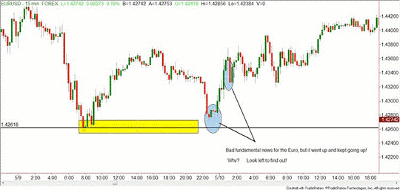Currency traders who focus too much on news and economic reports often overlook the supply/demand relationships on the charts, missing profit opportunities as a result.
After being an instructor with Online Trading Academy for going on five years now, there are questions that come up in every single class: "Why did this currency pair move opposite of what the fundamentals would imply?" or "Who is selling /buying this pair when the news said it should go the other way?" or "What caused the pair to move that direction?"
My response is usually, "Why does it matter to you?"
Now I understand that everyone is different; from how they react to the markets to their personal "need" to know certain things. There are certain personalities and character traits that people have that drive them to want to know why things happened a certain way. There isn't anything wrong with that in the normal world, but in the world of trading, it isn't helping.
You must understand how supply and demand works, but why a currency pair reacted to a bit of news in a certain way is irrelevant!
Most of the successful traders I know don't really care about the "whys." Most are looking to the left on the charts to see previous imbalances in supply and demand and place their trades accordingly.
Some instructors I speak to actually laugh out loud when I bring this question up: "Instructor X, do you care why this pair moved from this level?" Response: "Why would I care? Trying to figure out the 'why' doesn't get me paid. It just does. Do you want to be an analyst or a trader?"
By the time you read through an entire economic announcement and try to decipher why a currency pair moved one direction, the move may be half over!
In the following chart, the light blue circles indicate when a couple of pieces of fundamental news came out for the euro (EUR). The first circle indicates French industrial production, while the second indicates when Italian industrial production was released.
The French Production number was expected to be +.5% and came in at -.9%, while its previous figure was revised up .1% to .5%. The Italian Production number came in at .4% with an expectation of .6%, while the revision was also up .1% to 1.5%. Both came in worse than the expected number, while the previous readings where both revised higher. (Don't even get me started on my opinion on revisions! If they don't have enough information to give you the correct number, why give it to you at all? Think about it.)
These latest numbers came out much worse than expected, while the revisions (or previous lies?) were moved up .1% each. Shouldn't the EUR/USD have gone down on the bad EUR news?
Well, as the analysts in the world were discussing and arguing what the EUR/USD should be worth, the traders were hitting the buy button because of the obvious demand level to the left!
This leads us to thinking like a trader versus thinking like an analyst. We have to separate the two thought processes in our heads! Traders need to be decisive: Buy, sell, or wait right here and right now. This is where a trader makes his or her money.
There is nothing inherently wrong with understanding macroeconomics, government policies, etc., and how they may be hurting or helping the value of an individual currency. In fact, I believe most people should spend a lot more time understanding these concepts. The important distinction is that you must separate the concepts of fundamental value and technical value to be a consistently profitable trader.
It may not be easy to separate these two concepts in your head at first, but I guarantee if you can do it, you will trade better!
See related: Trade Headlines without Becoming One
By Rick Wright, instructor, Online Trading Academy





















